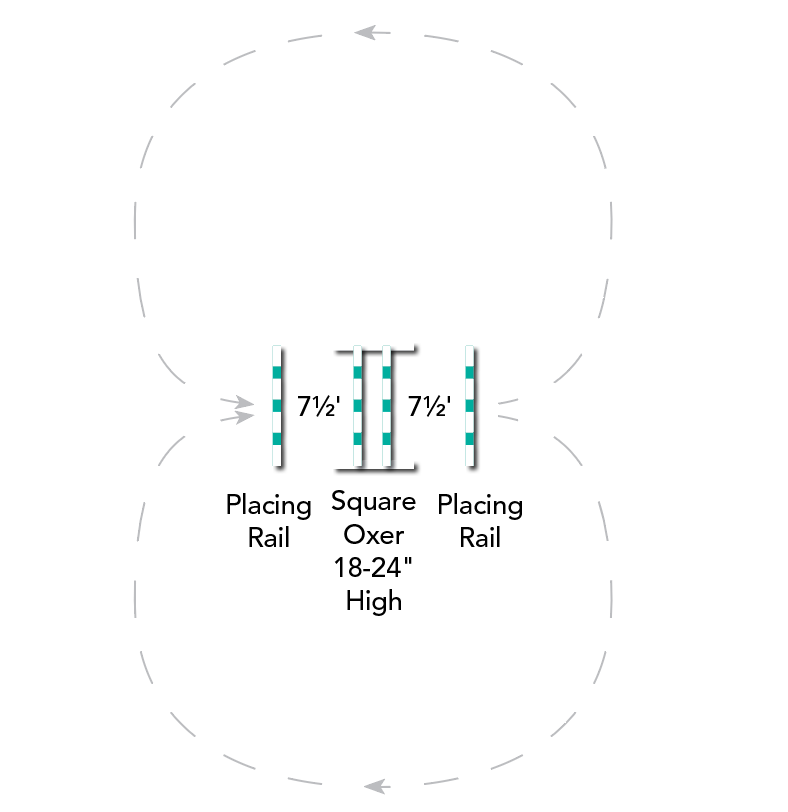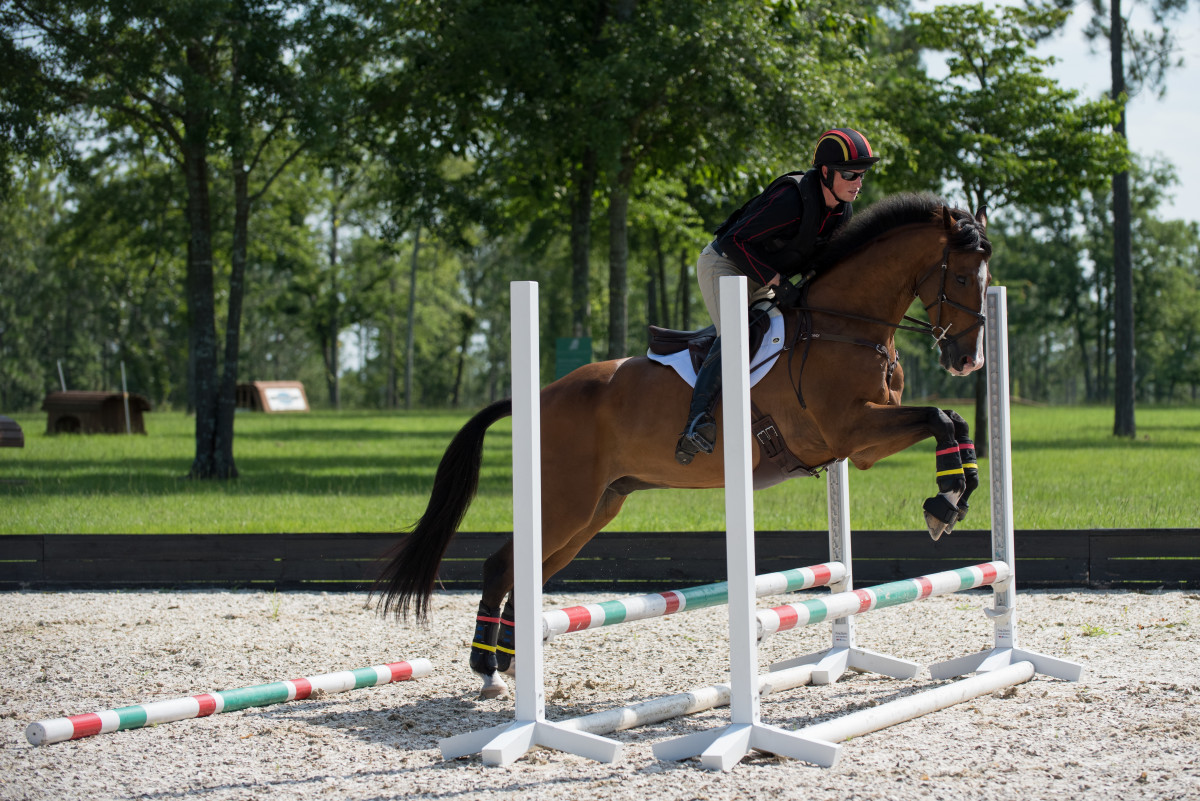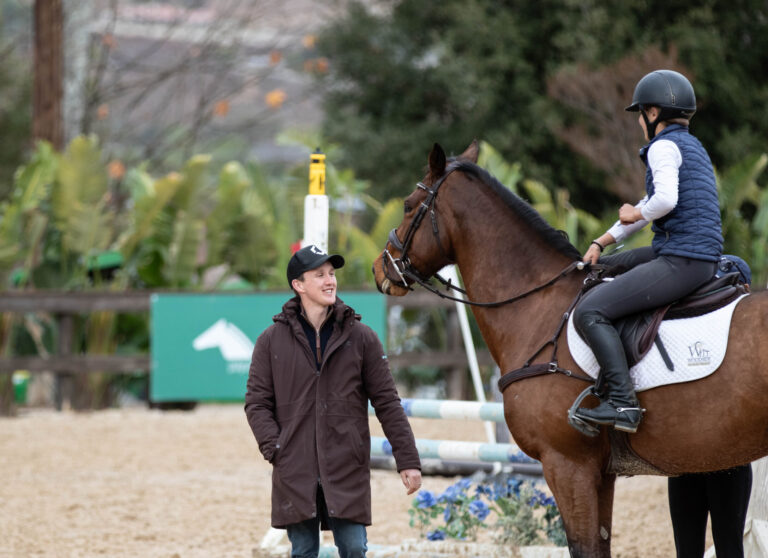At every level of eventing, horses and riders are expected to be able to negotiate some terrain during the cross-country phase. Rarely will an entire course be ridden on flat ground. As a competitor moves up the levels, the terrain questions become more challenging and frequently seen.
A jump on top of a mound, often called a “pimple jump,” is seen on cross-country courses at all levels. The complexity of this question increases as you move up the levels from a small log in the middle of a mound to a taller jump presented in combination with additional fences on either side of the mound.
No matter what type of fence you’re jumping, the primary thing to practice is maintaining the balance and energy appropriate for the challenge presented. If you get to the jump weak and unbalanced, you might incur a penalty or have an uncomfortable jump that will affect the horse’s confidence or your approach to the next fence.
For a jump on top of a mound, the best strategy is to have the horse well put together before you get to the threshold where the ground starts to rise. Sometimes the horse will peek at the fence a stride out or when he’s just about to take off, which diminishes his power and weakens the quality of his jump. You want to feel him snap off the ground at the base of the fence. Have plenty of power when you hit the upslope and use plenty of supportive leg and you’ll be in good shape.
In this article, I’ll share how to prepare a horse to negotiate a mound with a jump on top and then explain how to ride it.
Before we begin, here’s one of my training secrets: I frequently jump with a dressage whip. If my horse isn’t snapping off the ground and feels like he’s jumping out of mud, I can reinforce my leg aids with a dressage whip. A little tap behind the leg to encourage a pop off the ground can be achieved without removing my hand from the rein like I would have to with the short whip and without compromising the horse’s straightness. When using a short crop, the rider must remove her hand from the rein and it’s just about impossible to maintain straightness in that moment. A consistently straight horse is critical for success in all phases.
Skills to Teach First
Early in a horse’s training, I introduce an exercise that helps a horse jump in a good shape and think about his footwork. For the purposes of jumping a fence on a mound, with this exercise I am also teaching the horse to not rush and instead be patient, thoughtful and use his body to his advantage.
Why is this important? Well, in modern course design, the jumps can’t get any narrower or more angled than they already are, so terrain has become the X factor that can be used throughout the levels to expose weaknesses in training. If your horse isn’t balanced or is a little on the forehand, terrain is going to magnify any error. Master a jump on a mound, and you’ll be set. This exercise is the starting point.
Set an 18-inch square oxer with a placing rail 7½ feet in front of the fence and 7½ feet behind the fence. Starting at the trot, jump it several times on a big figure-eight pattern with the jump in the middle, changing direction each time, but make sure your horse is perpendicular to the jump when he reaches it. Your goal is to have two big circles joined over top of the fence. Once the horse understands the exercise at the trot and jumps with ease, practice riding it at the canter. The distance for the placing rails will be the same whether you trot or canter. With more experienced horses, you can tighten the figure eight down to 10 meters on either side. The horse often won’t expect the landing rail so he probably will peek at it the first couple of times, but it will teach him to be quick on his feet and jump in a round shape.

When you start to canter the exercise, if your horse is struggling and breaking to the trot, let him work out the exercise at the trot. If he continues to have a hard time placing his feet or is not strong enough to adequately collect his stride at the canter, you can push out the rails a little to give him more room.
Horses are very accustomed to jumping single fences without distraction. Putting placing rails on either side of the jump is a lot of stimulus for young or green horses. Practicing this exercise teaches horses to adapt on the fly without becoming overwhelmed. Letting them practice poise in the decision-making process is important because the more complexity you can present them with in the arena, the better shot you’ll have at developing a careful but quick horse on cross country. Keep in mind to give your horse as much time as possible to figure out what is being asked. Never rush him off the ground.

We introduce this exercise early on in a young horse’s training, from the time he can trot and canter rails on the ground. With young or green horses, you can make the oxer really small and move the placing rails out a little, but even with the experienced horses, the jump is never over 2 feet. That way, if they make a mistake there is not a huge repercussion. In the development process with horses, I strongly believe you have to keep the work physically easy but mentally challenging or the other way around. It should not be both physically and mentally challenging at the same time because you risk eroding a horse’s confidence if he makes major mistakes with significant repercussions. This often brings the horse to a point where he doesn’t want to learn. Keep him enjoying the process.
Once a horse is comfortably cantering over the oxer with placing rails on a figure-eight pattern, he is ready to be introduced to mounds.
An Introduction to Mounds
For a green or inexperienced horse, allow him to walk, trot and canter over a plain mound. Give him the opportunity to discover his own balance without the rider interfering too much.
Next, place three trot poles on the top of the mound about 3½ feet apart so the horse can start thinking about his footwork and get used to having an additional element in association with the terrain.
Let the horse sort out the strides on his own. Your job is to keep an encouraging leg to help him maintain his energy from one side of the mound to the other. A soft hand encourages relaxation and proper use of the topline and head and neck by giving him the freedom to stretch down. Often a horse is going to drop his head to look at the jump and a restrictive hand makes that impossible.
Once the horse has mastered trot poles on the mound, you can push the three poles together to create a substantial canter pole. This is the horse’s first real introduction to a jump on top of a mound. Practice keeping your leg on and a soft contact with the bit. Once again, let the horse sort out the striding.
If that’s all you do the first day, no problem. When the horse understands and feels comfortable with this exercise, you can set up a jump on the crest of the mound. A low vertical—no more than 3 feet—is appropriate for schooling.
Negotiating a Mound Jump
Approach and Setup
Speed is the number one problem with this type of cross-country question. Slow down! There is so much time between fences on cross country, especially at the lower levels, it’s easy to get lulled into thinking you have a well-balanced, appropriately slow canter when the horse’s stride is actually getting longer and faster. Then when you get to the jump, you have to work a lot harder to get the right canter back, which uses up seconds on the clock. You have to be sure you’re maintaining a quality canter or gallop between fences so you save time setting up and have better jumping efforts. At the lower levels, you might get away with being long and flat, but as you advance up the levels, that will come back to bite you.
How I ride the approach to a jump on a mound depends on how adjustable the horse is. If he is super-adjustable, I start slowing down about six strides out. If he is stronger or less adjustable, I give a mini half-halt about 15 strides out to gauge where he is. If he is really responsive, great. If not, I start setting him up sooner. If you check in to see where your horse is in terms of attention and obedience, you get a feel for how much time is required for the right setup. When in doubt, start early. This is not where you’re going to win by saving a few seconds.
For this type of fence, you want a round, compact canter but a slow speed. As long as the horse can maintain his power and straightness, slower is better. If you’re coming in fast, maintaining an appropriately balanced canter that doesn’t end up on forehand will be difficult. If the horse ends up long or quick, he will feel like he has run into the bottom of the bank and belly slide across the top. Power is the key, not speed. So work to create power in the canter so you have a nice round jump. A fast, flat canter will give you a fast, flat jump, and that’s when accidents happen. In general, you want the horse to change his shape so the canter is packaged, energetic and quick-footed when needed. The oxer-and-placing-rails exercise that we started with helps teach a horse what this canter feels like and how it makes his job easier.
Compress the stride to create power in the hindquarters and lift in the shoulders. The goal is to create amplitude not stride length. Use a supportive, hugging leg to “lift” the belly up. When you do that, the horse might want to go faster and more forward. If he does, use a compensatory amount of hand to restrict his speed while applying leg at the same time to shorten the stride while maintaining power. When you feel him compress the stride as you asked, make sure you soften your hand again. The horse should be relaxed in the topline so he can have a round shape to complete the jump. If he gets there tight in his topline, he’ll be more apt to trail his hind end and potentially knock his stifles or drag his hind legs.
In a perfect world, you can be accurate and get a distance that is deeper as opposed to longer. The deeper a horse is, the rounder shape he will make. But don’t get too fixated on the distance. I’d be way happier to be in a perfect balance and an appropriate stride length with an inaccurate distance than to have a long, flat stride at the point of takeoff. Don’t be afraid to be inaccurate with the distance as long as the canter is correct.
When it comes to jumps on a mound, I don’t mind if the horse breaks to trot. If that happens, I keep my leg on and support his front end by keeping a soft feel of the mouth without pulling. I don’t try to push the horse back into the canter a few strides in front of the fence because that would throw him off balance and distract him from thinking about the fence. Keep the most balanced gait you can. The gait itself is secondary.
Up and Over:
At all times, regardless of the height or complexity of the jump, the horse must never feel rushed. You might be nervous, but don’t be too aggressive or you will put him at a disadvantage. The horse needs time to assess what is being asked of him.
In the last three or four strides, be soft with your hand so the horse can use his body. If you’ve already established a good canter, the energy you’ve created should carry him up the hill without much effort. Keep your leg on to support him and show him where he’s going, but it should feel like an effortless rise. If you need a drastic amount of leg to keep going, you probably didn’t have enough power in the canter. Over the top of the jump, you’ll go almost hands off so he can jump the best he can, using his neck and back to the fullest.
It’s tempting to throw your upper body forward to come off the horse’s back and “help” him over the fence. You have to be patient with your upper body. If anything, you want to be a little behind the motion but with enough freedom in your hip that you won’t get left behind when the horse takes off. With this approach, you may feel like you’re in more of a drop position on the backside, but because you didn’t throw your upper body forward, you didn’t restrict the horse’s bascule.
Be careful not to pinch with your knees. Especially if you pitch forward, pinching knees will act as a fulcrum and you’ll find yourself flossing your teeth on the horse’s mane. Think about keeping your knee off the saddle and allowing more weight in your heel. That will keep you anchored without using a lot of strength.
Horses tend to land off a mound jump in good balance, which is nice if it is a fence in a combination. Just sit up, put your leg on and steer.
If you teach your horse the skills needed to ride a jump on a mound and then help him maintain the balance and energy appropriate for this challenge, you’ll be rewarded with a successful effort.
About Doug Payne
Five-star eventer Doug Payne has brought numerous young horses from the lowest to the highest levels of the sport. He also competes in grand prix show jumping and upper-level dressage. He is a well-known international competitor, trainer, judge, coach and author. Payne has produced several horses to the top level of eventing and rode Starr Witness on the U.S. Equestrian Team at the 2019 Pan American Games in Lima, earning team gold and individual fourth. The same year, Payne and Vandiver finished fifth in the Land Rover Kentucky Three-Day Event presented by Mars Equestrian CCI*****-L. He lives in Aiken, South Carolina, with his wife and fellow five-star rider, Jessica, and their children, Hudson and Abby.
This article originally appeared in the Winter 2020 issue.











